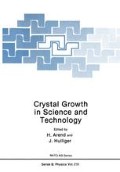Abstract
A crystal is said to be twinned when it contains regions whose atomic structures, being uniform in each region, are mutually related by some well defined law and this law is repeatedly observed in many samples of the crystalline species. These requirements distinguish twins from polycrystalline aggregates in which the crystallites are randomly oriented. Since the beginning of crystallography as a science, twinned crystals provided objects interesting to describe. Their investigation was rather academic, with useful aspects in the determination of minerals. New impulses for the investigation of twinning have been connected with practical uses of crystalline materials (metals, quartz).
Access this chapter
Tax calculation will be finalised at checkout
Purchases are for personal use only
Preview
Unable to display preview. Download preview PDF.
References
G. Friedel, Bull. Soc. Franc. Mineralogie, 56:262 (1933).
R. W. Cahn, Adv. Phys., 3:363 (1954).
B. K. Vainshtein, V. M. Fridkin and V. L. Indenbom, “Modern Crystallography”, vol. II, Springer-Verlag, Berlin (1981).
G. Donnay and J. D. H. Donnay, Canad. Mineral., 12:422 (1974).
P. Ramdohr and H. Strunz, “Klockmanns Lehrbuch der Mineralogie”, Ferdinand Enke Verlag (1967).
M. J. Buerger, in: “Phase Transformations in Solids”
R. Smoluchowski, ed., p. 183, Wiley, New York (1951).
H. Tabata and E. Ishii, J. Crystal Growth, 49:753 (1980).
R. C. De Vries, J. Am. Ceram. Soc., 42:547 (1959).
J. W. Nielsen, R. C. Linares and S. E. Koonce, J. Am. Ceram. Soc., 45:12 (1962).
J. W. Christian, “The Theory of Transformations in Metals and Alloys”, Pergamon Press, Oxford (1965).
L. A. Shuvalov, A. A. Urusovskaya et al., “Modern Crystallography”, vol. IV, Springer-Verlag, Berlin (1981).
L. A. Shuvalov, J. Phys. Soc. Japan, 28 Suppl., 38 (1970).
K. Aizu, Phys. Rev., B2:754 (1970).
V. Janovec, V. Dvorak and J. Petzelt, Czech. J. Phys., B25:1362 (1975).
V. Janovec, Czech. J. Phys., B22:974 (1972).
V. Janovec, Ferroelectrics, 12:43 (1976).
R. E. Newnham and L. E. Cross, Mat. Res. Bull., 9:927,1021 (1974).
K. Aizu, J. Phys. Soc. Japan, 34:121 (1973).
R. E. Newnham, American Mineralogist, 59:906 (1974).
J. Fousek and V. Janovec, J. Appl. Phys., 40:135 (1969).
J. Fousek, Czech. J. Phys., B21:955 (1971).
J. Sapriel, Phys. Rev., B12:5128 (1975).
L. A. Shuvalov, E. F. Dudnik and S. V. Wagin, Ferroelectrics, 65:143 (1985).
L. G. Shabelnikov, V. Sh. Shekhtman and O. M. Tsarev, Fizika Tverdogo Tela, 18:1529 (1976).
N. Ziegler, M. Rosenfeld, W. Känzig and P. Fischer, Helv. Phys. Acta, 49:57 (1976).
A. M. Balagurov, I. D. Datt, B. N. Savenko and L. A. Shuvalov, Fizika Tverdogo Tela, 22:2735 (1980).
J. R. Barkley and W. Jeitschko, J. Appl. Phys., 44:938 (1973).
J. Tomek, V. Janovec, J. Fousek and Z. Zikmund, Ferroelectrics, 20:253 (1978).
V. K. Wadhawan and M. S. Somayazulu, Phase Transitions, 7:59 (1986).
M. Glogarova and J. Fousek, Phys. Stat. Sol., (a) 15:579 (1973).
A. M. Balagurov, N. C. Popa and B. N. Savenko, Phys. Stat. Sol., (b) 134:457 (1986).
C. Boulesteix, Phys. Stat. Sol., (a) 86:11 (1984).
S. Mendelson, Ferroelectrics 37:519 (1981).
J. Fousek and M. Glogarova, Jap. J. Appl. Phys., 4:403 (1965).
J. Fousek and M. Glogarova, Ferroelectrics, 11:469 (1976).
S. W. Meeks and B. A. Auld, Appl. Phys. Lett., 47:102 (1985).
A. Feisst and P. Koidl, Appl. Phys. Lett., 47:1125 (1985).
W. Wang, Q. Zhon, Z. Geng and D. Feng, J. Crystal Growth, 79:706 (1986).
W. Wang and M. Qi, J. Crystal Growth, 79:758 (1986).
J. C. Burfoot and G. W. Taylor, “Polar Dielectrics and Their Applications”, Macmillan, London (1979).
J. W. Laughner, R. E. Newnham and L. E. Cross, Phys. Stat. Sol., (a) 56:K83 (1979).
E. Bertagnolli, E. Kittinger and J. Tichf, J. Appl. Phys., 50:6267 (1979).
K. Nassau, H. J. Levinstein and G. M. Loicono, J. Phys. Chem. Solids, 27:989 (1966).
S. C. Abrahams, J. L. Bernstein, J. P. Chaminade and J. Ravez, J. Appl. Cryst., 16:96 (1983).
P. W. Haycock and P. D. Townsend, Appl. Phys. Lett., 48:698 (1986).
G. Metratand A. Deguin, Ferroelectrics, 13:527 (1976).
B. Brezina and M. Havránková, Ferroelectrics Letters, 4:81 (1985).
P. J. Lock, Appl. Phys. Letters 19:390 (1971).
B. BBrezina and M. Havránková, Crystal Res, and Technology, 20:781,787 (1985).
Z. Zikmund and J. Fousek, “Proc. Int. Symp. on Applications of Ferroelectries”
V. Wood, ed., Lehigh University, Bethlehem, Pa (1987).
Z. Zikmund and J. Fousek, Ferroelectrics, 79:73 (1988).
Author information
Authors and Affiliations
Editor information
Editors and Affiliations
Rights and permissions
Copyright information
© 1989 Plenum Press, New York
About this chapter
Cite this chapter
Březina, B., Fousek, J. (1989). Twinning in Crystals. In: Arend, H., Hulliger, J. (eds) Crystal Growth in Science and Technology. NATO ASI Series, vol 210. Springer, Boston, MA. https://doi.org/10.1007/978-1-4613-0549-1_10
Download citation
DOI: https://doi.org/10.1007/978-1-4613-0549-1_10
Publisher Name: Springer, Boston, MA
Print ISBN: 978-1-4612-7861-0
Online ISBN: 978-1-4613-0549-1
eBook Packages: Springer Book Archive

